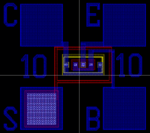ronaldomponte
Junior Member level 2
Does anyone here have experience in writing LVS check rule file using SVRF from Calibre and can give me some help to find the connectivity error in my LVS code?
I am coding the device definition for a vertical npn BJT device.
As long as someone does candidate to help me I share my code.
Thanks!
I am coding the device definition for a vertical npn BJT device.
As long as someone does candidate to help me I share my code.
Thanks!
